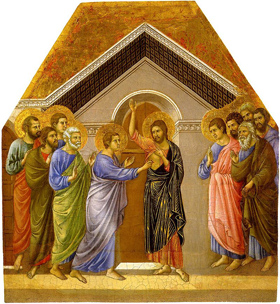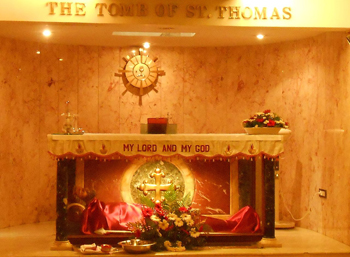For Sunday April 8, 2016
Lectionary Readings (Revised Common Lectionary, Year B)
Acts 4:32-35
Psalm 133
1 John 1:1-2:2
John 20:19-31
About ten years ago, I made a pilgrimage to Kerala, south India, to research St. Thomas, the protagonist of this week’s Gospel reading. I was a graduate student at the time, eager to learn everything I could about the disciple whose name I bear — the disciple best known in my homeland as “The Apostle of India.”
Though St. Thomas’s afterstory isn’t well known in the West, Indian tradition (preserved by village bards in a rich oral tradition of songs, ballads, and dances) holds that Thomas sailed to the east coast of Kerala in A.D 52, intending to preach to the Jewish colonies settled near Cochin. After making both Jewish and Brahmin converts, he followed the coastline south, winning hundreds of followers in the villages of my ancestors.
After establishing ezharappallikal (seven and a half churches) along the waterways of Kerala, he crossed the subcontinent to Mylapore, on the west coast near Madras. There his preaching aroused the hostility of devout Brahmins, who, jealous of his proselytizing successes, speared him to death in A.D 72. The martyr’s relics stayed in Mylapore until 232 A.D, when an Indian king carried them to Edessa, a city in modern-day Turkey. In 1258, the relics were taken to Italy, where they remain to this day. South Indian Christians, however, still venerate Mylapore as the apostle’s official resting place, and many hundreds make pilgrimages to his death site each year.
 |
As I learned during my summer in Kerala, the variations on Thomas’s Indian story are countless. Some sources claim that Thomas met the Magi on his way to India, and baptized the famous wise men himself. The Passing of Mary, an apocryphal text attributed to Joseph of Arimathea, describes how God miraculously transported Thomas home from India to witness Mary’s assumption to heaven. (In a fascinating reversal of the "doubting disciple" story, The Passing of Mary claims that the eleven apostles refused to believe Thomas, until he verified the story by showing them the girdle Mary dropped on her way to heaven.) Other accounts describe miraculous healings, exorcisms, and ecstatic visions, even crediting the dust in Thomas’s grave with potent healing powers. St. Ephrem, a devotional hymn writer of the 4th century, quoted the devil himself speaking in awe of Thomas, “the Apostle I slew in India.” According to oral tradition, some Christian communities in South India teach that the apostle literally lives among them as a patron saint, healer, and protector, and my own extended family considers him the father of our faith: we still call ourselves “St. Thomas Christians.”
I write all of this because Thomas often gets a bad rap in the West. Though his story is one of the few in the three-year cycle of the Revised Common Lectionary that never changes (we always read about his encounter with the resurrected Jesus on the Sunday after Easter), it is often cast in negative terms. He’s most famously known as “Doubting Thomas,” the cynic, the holdout. His reluctance to accept the testimony of his fellow disciples, his insistence on physical proof, his late arrival to the joyous belief of his peers — these are often described as spiritual flaws. As signs of stubbornness, or of a weak faith.
But weakness is not what I see in the patron saint of Indian Christianity. I see a man who yearned for a living encounter with Jesus. A man who couldn’t settle for someone else’s experience of resurrection, but stuck around in the hope of having his own. A man who dared to confess uncertainty in the midst of those who were certain. A man who recognized his Lord in woundedness, not glory. And a man whose intimate experience of Jesus finally compelled him to carry the Good News to the ends of the earth.
According to John’s Gospel, Thomas had to wait in suspense and uncertainty for a whole week after his friends first told him they’d seen Jesus. What, I wonder, did that week feel like for the disciple who missed Jesus the first time around? Did he pity his fellow disciples for their grief-stricken delusions? Or did he fear (as I so often do) that he’d missed the memo, missed the boat, missed the glory? That he was destined only ever to know God secondhand?
| |
What strikes me most about Thomas’s story is not that he doubted, but that he did so publicly, without shame or guilt. And what I love about Jesus’s response is that he met Thomas right where he was, freely offering the disciple the testimony of his own wounds, his own pain. After such an encounter, I can only imagine the tenderness and urgency with which Thomas was able to repeat Christ’s words to my ancestors in India: “Blessed are those who have not seen, and yet have believed.”
I went in search of Thomas ten years ago because I wanted to understand more about my religious heritage. I wanted to walk where Thomas walked, worship in the churches he established, and listen to the stories his spiritual descendants still tell about his legacy. But more than that, I wanted to see the fruits of a life lived in honest acceptance of doubt. I wanted to experience how God can still bless and multiply the witness of a disciple who struggled to trust, who yearned for God but found the path of faith rocky and hard. Because isn’t this all of us, on the Sunday after Easter? Don’t we all wrestle with hidden doubts, hidden fears? Don’t we all wonder sometimes if the miracle of resurrection will hold in Ordinary Time?
If nothing else, Thomas reassures me that faith doesn’t have to be straightforward; the business of accepting the resurrection, of living it out, of sharing it with the world, is tough. It’s okay to waver. It’s okay to take our time. It’s okay to hope for more.
On one of my last days in India, I visited “The Mount of St. Thomas,” a sacred place for reflection and prayer in the hill country of Vagamon, about three hours from my birthplace. Fog obscured the hills on the morning I visited, settling, dissipating, and settling again, but between the patches of fog were bits of bright, improbable color. Statues. The hills rising in every direction were dotted with colorful, painted statues. Christ knelt among a cluster of mossy rocks to my far right, his dark head bowed in prayer. Across the valley another Christ figure hovered over a huge blue and green globe, his feet grazing the Arctic Circle, his arms outstretched to embrace invisible stars.
Soon I saw Peter, Andrew, Thaddeus, James…. They sat, knelt, stood, or reclined, eleven friends of Jesus winding their holy way up the hills to a life-size crucifixion scene. But Thomas was not among them. I found him on a hill of his own. Even from a distance, he was huge, his face deep in fog, his body raised atop a pedestal one hundred and twenty stone steps above the valley floor. At the base of the statue, the doubting disciple’s famous confession, “My Lord and my God,” appeared in my mother-tongue, Malayalam. He wore a light blue cloak over a white tunic, and held a black Bible in his left hand. In his right he gripped a staff or a spear, and his forefinger, a witness to the world, was covered in blood. Behind the statue, an austere wooden cross leaned against a stone, a stark reminder of the apostle’s martyrdom.
 |
I stood and looked at him for a long time. He was majestic in that place, elevated above his peers. But he was weathered and lonely looking, too. There was no church to shelter him. No temple, no shrine, no candles and flowers to soften the wind and rain battering his face. This was Thomas truly in India, alone among strangers, and far from home, captivated by a piece of Good News he yearned to share with the world. As I stood there, it dawned on me that this is the miracle of the resurrection. This is the enduring power of the living Christ. This is what happens when we insist on seeing and knowing God for ourselves. The story becomes our own, the story becomes true. And then it spills over to bless the world.
The doubting disciple. The holdout. The latecomer to the Resurrection. He is the Apostle to India, the patron of those who yearn. Two thousand years later, I am grateful.
Image credits: (1) Wikipedia.org; (2) Trinity Iconography Institute; and (3) Wikipedia.org.





